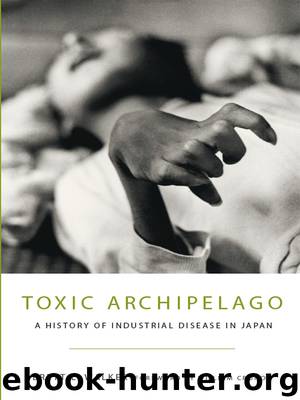Toxic Archipelago: A History of Industrial Disease in Japan by Walker Brett L

Author:Walker, Brett L.
Language: eng
Format: epub
ISBN: 9780295803012
Publisher: University of Washington Press
Bioaccumulation
What fishers had come to understand through their dead cats, even without the help of scientists, was bioaccumulation. In aquatic environments, toxins such as methylmercury and PCBs (polychlorinated biphenyls) concentrate in extraordinarily high levels because of the length of marine food chains and because the buoyancy of water allows aquatic organisms to spend less energy fighting gravity. Subsequently, less energy is lost between links in the chain and more links can be added, meaning higher concentrations of toxins in an organism over time. For this reason, the levels of mercury in the fish pulled from Shiranui waters were in some instances far higher than the mercury content of the water itself. Equally, because human mothers became another link in the food chain, and their fetuses another link still, the mercury that was passed from mothers to their unborn children reached even higher levels. (Remember, fetuses float in a liquid environment, too.) Sadly, the unborn children of Minamata inhabited the highest link in the food chain: they served as the final destination of, and hence as a repository for, Chisso's deadly toxins.23 In part, these children became the offspring of Chisso chemicals.
Kumamoto University researchers focused on the shellfish of Minamata Bay as possible vectors for transferring heavy metals to human victims. One of the most ubiquitous shellfish was an intertidal mussel called hibarigaimodoki (Hormomya mutabilis). If fetuses stood at the top of the food ladder, then mussels—or, more accurately, the plankton they ate—occupied the lower rungs. In 1968, researcher Shoji Kitamura, from Kumamoto University, published results of tests designed to measure the mercuric content of this important source of food for both the human and nonhuman inhabitants of Minamata. Sadly, the exact dates of the study remain unknown, but Kitamura appears to have collected data between May and July 1959. His results revealed that the average mercuric content of the shellfish was about 30 μg/g (or thirty micrograms of constituent per gram of tissue; or thirty parts per million). He discovered the highest amount of mercury in the shellfish off the eastern coast of Koiji Island, which measured 39 μg/g. Interestingly, Kitamura discovered no correlation between levels of mercury in the mussels and levels in the mudflats, mangroves, and rocks they inhabited.24 But what mercury shellfish harbored easily transferred to other organisms, including people. Separate experiments by Katsuro Irukayama revealed that toxins remained in the muscles and organs of shellfish even after they had been dried or boiled, and that nearly 20 percent of the mercury could be removed from the shellfish through simulated digestion. The results: shellfish proved excellent vectors for delivering industrial toxins to people.25 Just as cadmium from copper mines poisoned the rice, the staple of paddy farmers in Tochigi Prefecture, mercury from Chisso poisoned the shellfish consumed almost daily by coastal communities. This is why I focused on food and food webs in the introduction.
Even though the shellfish contained dangerously high amounts of mercury, Kitamura actually provided a low estimation of the mercuric content of hibarigaimodoki. Other
Download
This site does not store any files on its server. We only index and link to content provided by other sites. Please contact the content providers to delete copyright contents if any and email us, we'll remove relevant links or contents immediately.
| Anatomy | Animals |
| Bacteriology | Biochemistry |
| Bioelectricity | Bioinformatics |
| Biology | Biophysics |
| Biotechnology | Botany |
| Ecology | Genetics |
| Paleontology | Plants |
| Taxonomic Classification | Zoology |
Sapiens: A Brief History of Humankind by Yuval Noah Harari(14322)
The Tidewater Tales by John Barth(12627)
Mastermind: How to Think Like Sherlock Holmes by Maria Konnikova(7281)
Do No Harm Stories of Life, Death and Brain Surgery by Henry Marsh(6908)
The Thirst by Nesbo Jo(6882)
Why We Sleep: Unlocking the Power of Sleep and Dreams by Matthew Walker(6659)
Life 3.0: Being Human in the Age of Artificial Intelligence by Tegmark Max(5519)
Sapiens by Yuval Noah Harari(5325)
The Longevity Diet by Valter Longo(5044)
The Body: A Guide for Occupants by Bill Bryson(5033)
The Rules Do Not Apply by Ariel Levy(4912)
The Immortal Life of Henrietta Lacks by Rebecca Skloot(4552)
Animal Frequency by Melissa Alvarez(4430)
Why We Sleep by Matthew Walker(4395)
The Hacking of the American Mind by Robert H. Lustig(4342)
Yoga Anatomy by Kaminoff Leslie(4334)
All Creatures Great and Small by James Herriot(4277)
Double Down (Diary of a Wimpy Kid Book 11) by Jeff Kinney(4244)
Embedded Programming with Modern C++ Cookbook by Igor Viarheichyk(4143)
